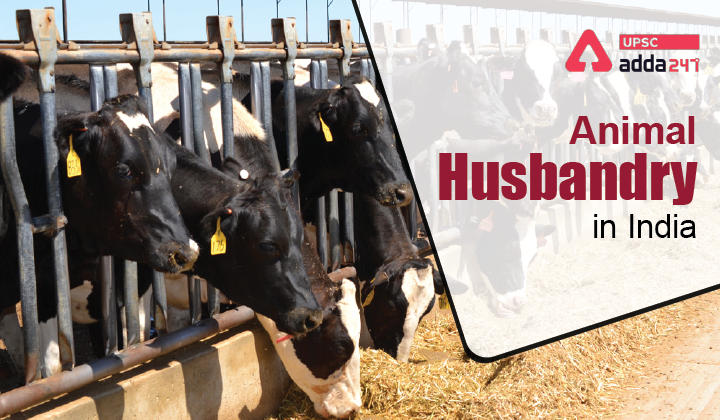Table of Contents
What is animal husbandry UPSC?
- Animal husbandry is the science of agriculture where animals are reared, bred and raised for meat, fiber, eggs, milk and other food products.
Animal husbandry in India
- Livestock sector contributes 4% of GDP and 25% of total Agriculture GDP.
- According to livestock census 2019, livestock in India witnessed an increase of 4.6% as compared to the previous census.
- Livestock productivity has been identified as one of the seven sources of income growth by the Inter-Ministerial Committee under the government’s target of doubling farmers’ income by the year 2022.
Importance of livestock farming in India
- Income: Unlike crop production, livestock are a secured source of income. Moreover, animals like sheep and goats are used to meet exigencies like marriage, treatment of sick persons, in the times of distress.
- Employment: Livestock provides employment to a large section of rural people who remain unemployed due to seasonal nature of crop production. Also, livestock reduces the risk of disguised unemployment in agriculture.
- Food: Livestock also provides with the basic nutritious foods like milk, egg, meat, etc thus ensuring healthy diet even in times of economic distress.
- Social security: The animals offer social security to the owners in terms of their status in the society. The families, especially the landless which own animals are better placed than those who do not.
- Gender equality: Animal husbandry promotes gender equality. More than 3/4th of the labour demand in livestock production is met by women. The share of women employment in the livestock sector is around 90% in Punjab and Haryana.
- Protection against disasters: Livestock are the best insurance against the drought, famine and other natural calamities. Majority of the livestock population is concentrated in the marginal and small size of holdings.
Potential of livestock farming in India
- India has 56.7% of the world’s buffaloes, 12.5% cattle, 2.4% camel (10th in camel population in the world) and 3.1% poultry (2nd largest poultry market in the world).
- Livestock sector contributes 4.11% of GDP and 25.6% of total Agriculture GDP.
Challenges of livestock farming in India
- Non-availability of superior quality breeding bulls.
- Shortage of fodder resources and ineffective control of animal diseases.
- Absence of field-oriented conservation strategy for indigenous breeds.
- Lack of skills and quality services to farmers for improving productivity and improper infrastructure to support the sector.
Government initiatives for livestock farming in India
- Development Programmes: Rashtriya Gokul Mission, National Programme for Dairy Development (NPDD), National Livestock Mission (NLM) and Livestock Census and Integrated Sample Survey (LC & ISS) as sub-schemes,
- Disease Control programme renamed as Livestock Health and Disease Control (LH & DC) which includes Livestock Health and Disease Control (LH & DC) scheme and National Animal Disease Control Programme (NADCP)
- Infrastructure Development Fund: Animal Husbandry Infrastructure Development fund (AHIDF) and the Dairy Infrastructure Development Fund (DIDF).
Recommendations for livestock farming in India
- Sufficient resources: Providing sufficient fodder and drinking water is the need of hour to increase productivity of livestock rearing in India, in the rain-shadow region.
- Marketing: Trade Policies like marketing have to be more effective for promotion of various livestock products like egg, fish, milk etc. and providing sufficient price to farmers by reducing influence of middlemen.
- Promoting indigenous breeds: Our indigenous breed of cattle shall be promoted, because most foreign breed cattle are not suitable to our climate and even provide low quality.
- Training: Necessary training and subsidies shall be provided to farmers to adopt livestock rearing as an alternate source of income.
- Research and development: Government also need to focus on Research & Development in livestock sector to increase per livestock productivity to provide more benefits to small & marginal farmers.
Read current affairs for UPSC





 TSPSC Group 1 Question Paper 2024, Downl...
TSPSC Group 1 Question Paper 2024, Downl...
 TSPSC Group 1 Answer key 2024 Out, Downl...
TSPSC Group 1 Answer key 2024 Out, Downl...
 UPSC Prelims 2024 Question Paper, Downlo...
UPSC Prelims 2024 Question Paper, Downlo...
